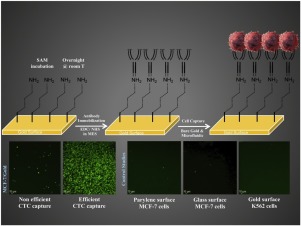当前位置:
X-MOL 学术
›
Colloids Surf. B Biointerfaces
›
论文详情
Our official English website, www.x-mol.net, welcomes your
feedback! (Note: you will need to create a separate account there.)
A comparative study on EpCAM antibody immobilization on gold surfaces and microfluidic channels for the detection of circulating tumor cells.
Colloids and Surfaces B: Biointerfaces ( IF 5.4 ) Pub Date : 2020-01-20 , DOI: 10.1016/j.colsurfb.2020.110808 Didem Cetin 1 , Meltem Okan 2 , Erhan Bat 3 , Haluk Kulah 4
Colloids and Surfaces B: Biointerfaces ( IF 5.4 ) Pub Date : 2020-01-20 , DOI: 10.1016/j.colsurfb.2020.110808 Didem Cetin 1 , Meltem Okan 2 , Erhan Bat 3 , Haluk Kulah 4
Affiliation

|
Detection of circulating tumor cells (CTCs) from the bloodstream holds great importance to diagnose cancer at early stages. However, CTCs being extremely rare in blood makes them difficult to reach. In this paper, we introduced different surface modification techniques for the enrichment and detection of MCF-7 in microfluidic biosensor applications using gold surface and EpCAM antibody. Mainly, two different mechanisms were employed to immobilize the antibodies; covalent bonding and bioaffinity interaction. Self-assembled monolayers (SAMs) formed on the gold surfaces were treated further for the immobilization of the antibody. The bioaffinity-based studies were performed with streptavidin and biotinylated EpCAM over the SAM coated surfaces. The cell attachment events were monitored using fluorescent microscope. Comparisons were made considering the length and functional end of alkanethiols and the positioning of the antibody. Then, these methods were integrated into a microfluidic channel system. Surface characterizations were performed with X-ray Photoelectron Spectroscopy, Atomic Force Microscopy, and contact angle measurements. The selectivity studies were carried out with EpCAM negative K562 leukaemia cell lines and the experiments were repeated for different types of surfaces, such as glass and polymer. Studies showed that long (n>10) and aromatic ring containing alkanethiols lead to better cell capture events compared to shorter ones. Results obtained from the comparisons are of importance for the gold surface-based microfluidic biosensor designs aimed for CTC detection.
中文翻译:

EpCAM抗体固定在金表面和微流体通道上以检测循环肿瘤细胞的比较研究。
从血液中检测循环肿瘤细胞(CTC)对于早期诊断癌症非常重要。但是,CTC在血液中极为稀少,因此很难获得。在本文中,我们介绍了使用金表面和EpCAM抗体在微流体生物传感器应用中富集和检测MCF-7的不同表面修饰技术。主要地,采用两种不同的机制来固定抗体。共价键和生物亲和力相互作用。在金表面上形成的自组装单分子层(SAMs)进行进一步处理以固定抗体。基于生物亲和力的研究是通过链霉亲和素和生物素化的EpCAM在SAM包被的表面上进行的。使用荧光显微镜监测细胞附着事件。考虑到链烷硫醇的长度和功能末端以及抗体的位置进行比较。然后,将这些方法集成到微流体通道系统中。用X射线光电子能谱,原子力显微镜和接触角测量进行表面表征。用EpCAM阴性K562白血病细胞系进行了选择性研究,并针对不同类型的表面(例如玻璃和聚合物)重复了实验。研究表明,与较短的链烷硫醇相比,较长的(n> 10)芳环含烷硫醇会导致更好的细胞捕获事件。从比较中获得的结果对于针对CTC检测的基于金表面的微流体生物传感器设计非常重要。
更新日期:2020-01-21
中文翻译:

EpCAM抗体固定在金表面和微流体通道上以检测循环肿瘤细胞的比较研究。
从血液中检测循环肿瘤细胞(CTC)对于早期诊断癌症非常重要。但是,CTC在血液中极为稀少,因此很难获得。在本文中,我们介绍了使用金表面和EpCAM抗体在微流体生物传感器应用中富集和检测MCF-7的不同表面修饰技术。主要地,采用两种不同的机制来固定抗体。共价键和生物亲和力相互作用。在金表面上形成的自组装单分子层(SAMs)进行进一步处理以固定抗体。基于生物亲和力的研究是通过链霉亲和素和生物素化的EpCAM在SAM包被的表面上进行的。使用荧光显微镜监测细胞附着事件。考虑到链烷硫醇的长度和功能末端以及抗体的位置进行比较。然后,将这些方法集成到微流体通道系统中。用X射线光电子能谱,原子力显微镜和接触角测量进行表面表征。用EpCAM阴性K562白血病细胞系进行了选择性研究,并针对不同类型的表面(例如玻璃和聚合物)重复了实验。研究表明,与较短的链烷硫醇相比,较长的(n> 10)芳环含烷硫醇会导致更好的细胞捕获事件。从比较中获得的结果对于针对CTC检测的基于金表面的微流体生物传感器设计非常重要。











































 京公网安备 11010802027423号
京公网安备 11010802027423号